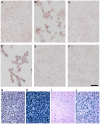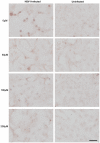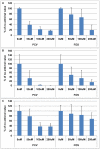Antivirals reduce the formation of key Alzheimer's disease molecules in cell cultures acutely infected with herpes simplex virus type 1
- PMID: 22003387
- PMCID: PMC3189195
- DOI: 10.1371/journal.pone.0025152
Antivirals reduce the formation of key Alzheimer's disease molecules in cell cultures acutely infected with herpes simplex virus type 1
Abstract
Alzheimer's disease (AD) afflicts around 20 million people worldwide and so there is an urgent need for effective treatment. Our research showing that herpes simplex virus type 1 (HSV1) is a risk factor for AD for the brains of people who possess a specific genetic factor and that the virus causes accumulation of key AD proteins (β-amyloid (Aβ) and abnormally phosphorylated tau (P-tau)), suggests that anti-HSV1 antiviral agents might slow AD progression. However, currently available antiviral agents target HSV1 DNA replication and so might be successful in AD only if Aβ and P-tau accumulation depend on viral DNA replication. Therefore, we investigated firstly the stage(s) of the virus replication cycle required for Aβ and P-tau accumulation, and secondly whether antiviral agents prevent these changes using recombinant strains of HSV1 that progress only partly through the replication cycle and antiviral agents that inhibit HSV1 DNA replication. By quantitative immunocytochemistry we demonstrated that entry, fusion and uncoating of HSV1, are insufficient to induce Aβ and P-tau production. We showed also that none of the "immediate early" viral proteins is directly responsible, and that Aβ and P-tau are produced at a subsequent stage of the HSV1 replication cycle. Importantly, the anti-HSV1 antiviral agents acyclovir, penciclovir and foscarnet reduced Aβ and P-tau accumulation, as well as HSV1, with foscarnet being less effective in each case. P-tau accumulation was found to depend on HSV1 DNA replication, whereas Aβ accumulation was not. The antiviral-induced decrease in Aβ is attributable to the reduced number of new viruses, and hence the reduction in viral spread. Since antiviral agents reduce greatly Aβ and P-tau accumulation in HSV1-infected cells, they would be suitable for treating AD with great advantage unlike current AD therapies, only the virus, not the host cell, would be targeted.
Conflict of interest statement
Figures










Similar articles
-
The helicase-primase inhibitor BAY 57-1293 reduces the Alzheimer's disease-related molecules induced by herpes simplex virus type 1.Antiviral Res. 2013 Sep;99(3):401-4. doi: 10.1016/j.antiviral.2013.07.003. Epub 2013 Jul 16. Antiviral Res. 2013. PMID: 23867133
-
Amyloid-β and p-Tau Anti-Threat Response to Herpes Simplex Virus 1 Infection in Primary Adult Murine Hippocampal Neurons.J Virol. 2020 Apr 16;94(9):e01874-19. doi: 10.1128/JVI.01874-19. Print 2020 Apr 16. J Virol. 2020. PMID: 32075924 Free PMC article.
-
Anti-HSV1 activity of brown algal polysaccharides and possible relevance to the treatment of Alzheimer's disease.Int J Biol Macromol. 2015 Mar;74:530-40. doi: 10.1016/j.ijbiomac.2015.01.003. Epub 2015 Jan 10. Int J Biol Macromol. 2015. PMID: 25583021
-
Herpes and Alzheimer's Disease: Subversion in the Central Nervous System and How It Might Be Halted.J Alzheimers Dis. 2016 Oct 18;54(4):1273-1281. doi: 10.3233/JAD-160607. J Alzheimers Dis. 2016. PMID: 27497484 Review.
-
Viral Hypothesis and Antiviral Treatment in Alzheimer's Disease.Curr Neurol Neurosci Rep. 2018 Jul 14;18(9):55. doi: 10.1007/s11910-018-0863-1. Curr Neurol Neurosci Rep. 2018. PMID: 30008124 Free PMC article. Review.
Cited by
-
Infectious agents and neurodegeneration.Mol Neurobiol. 2012 Dec;46(3):614-38. doi: 10.1007/s12035-012-8320-7. Epub 2012 Aug 17. Mol Neurobiol. 2012. PMID: 22899188 Free PMC article. Review.
-
Anti-viral Effects of Pavetta indica Methanolic Extract and Acyclovir on Behavioral and Biochemical Parameters in Streptozotocin-induced Alzheimer's Disease in Rats.Endocr Metab Immune Disord Drug Targets. 2024;24(13):1558-1571. doi: 10.2174/0118715303273145240110100341. Endocr Metab Immune Disord Drug Targets. 2024. PMID: 38685761
-
Shattering the Amyloid Illusion: The Microbial Enigma of Alzheimer's Disease Pathogenesis-From Gut Microbiota and Viruses to Brain Biofilms.Microorganisms. 2025 Jan 5;13(1):90. doi: 10.3390/microorganisms13010090. Microorganisms. 2025. PMID: 39858858 Free PMC article. Review.
-
Association between IgM anti-herpes simplex virus and plasma amyloid-beta levels.PLoS One. 2011;6(12):e29480. doi: 10.1371/journal.pone.0029480. Epub 2011 Dec 28. PLoS One. 2011. PMID: 22216291 Free PMC article.
-
Can an Infection Hypothesis Explain the Beta Amyloid Hypothesis of Alzheimer's Disease?Front Aging Neurosci. 2018 Jul 24;10:224. doi: 10.3389/fnagi.2018.00224. eCollection 2018. Front Aging Neurosci. 2018. PMID: 30087609 Free PMC article. Review.
References
-
- Ball MJ. "Limbic predilection in Alzheimer dementia: is reactivated herpesvirus involved? " Can J Neurol Sci. 1982;9:303–306. - PubMed
-
- Jamieson GA, Maitland NJ, Wilcock GK, Craske J, Itzhaki RF. Latent herpes simplex virus type 1 in normal and Alzheimer's disease brains. J Med Virol. 1991;33:224–227. - PubMed
-
- Itzhaki RF, Lin WR, Shang D, Wilcock GK, Faragher B, et al. Herpes simplex virus type 1 in brain and risk of Alzheimer's disease. Lancet. 1997;349:241–244. - PubMed
-
- Itabashi S, Arai H, Matsui T, Higuchi S, Sasaki H. Herpes simplex virus and risk of Alzheimer's disease. Lancet. 1997;349:1102. - PubMed
-
- Lin WR, Graham J, MacGowan SM, Wilcock GK, Itzhaki RF. Alzheimer's disease, herpes virus in brain, apolipoprotein E4 and herpes labialis. Alzheimer's Reports. 1998;1:173–178.
Publication types
MeSH terms
Substances
Grants and funding
LinkOut - more resources
Full Text Sources
Other Literature Sources
Medical
Molecular Biology Databases

